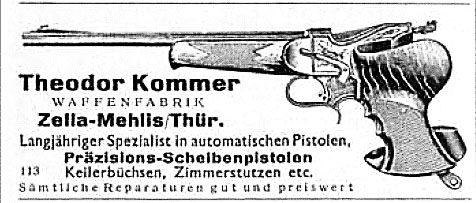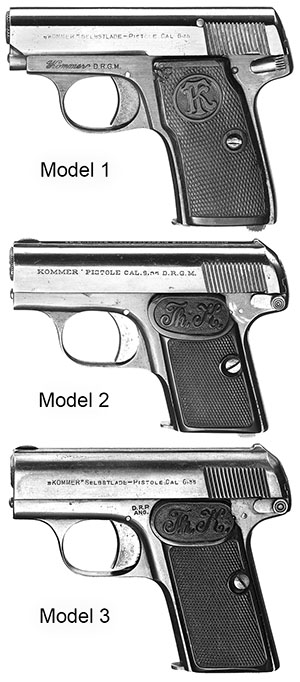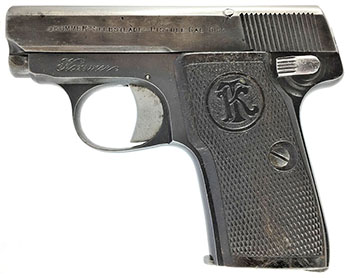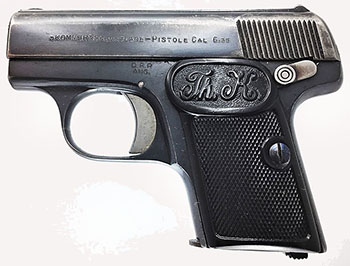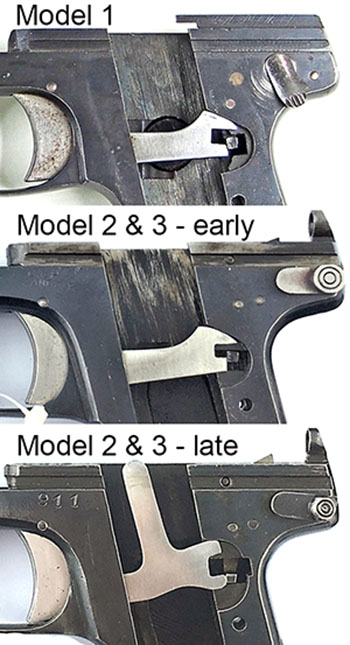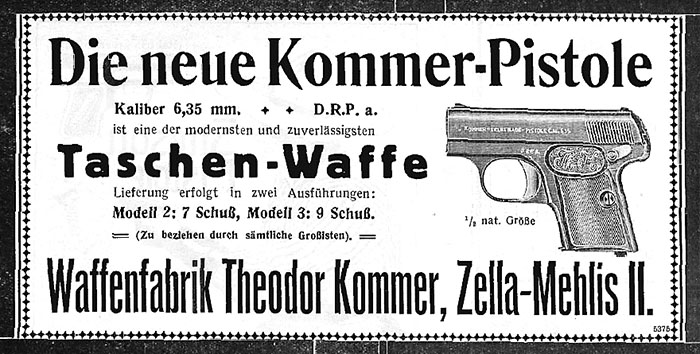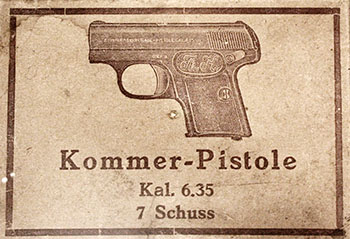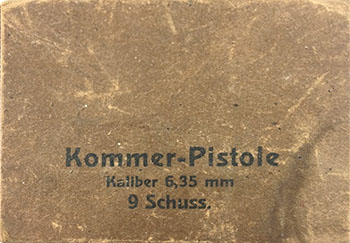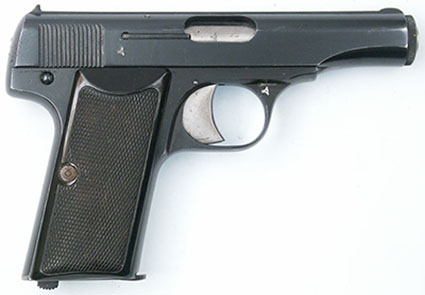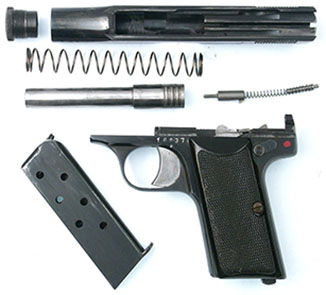 |
|||||||||||||||||||||||||||||||||||||||||||||||||||||||||||||||||||||||||||||||||||||||||||||||||||||||||||||||||||||||||||||||||||||||||||||||||||||||||||||||||||||||||||||||||||||||||
|
The Automatic Pistols of by Dr. Stefan Klein and Ed Buffaloe
In any case, arms production ended in 1940, though Siegfried Boers (in the magazine Deutsches Waffenjournal for March 1991) reports that during the war the company carried out contract work for the Carl Reich roller bearing factory located in Zella-Mehlis. Boers adds that the widow of a former Kommer partner burned the remaining company documents after the WWII. Kommer’s 6.35 mm Pistols
The contemporary author Gerhard Bock devotes only a small paragraph to Kommer in the 1941 edition of his book Moderne Faustfeuerwaffen und ihr Gebrauch. He writes: "The Theodor Kommer company, which is particularly known for its target pistols [...] produces self-loading pistols in 7.65 mm and 6.35 mm Browning [...]. In terms of construction, these models have no special features." Such a quick dismissal of Kommer's work does not do justice to the guns themselves—they are, after all, superbly crafted weapons that were competitive against such well-known pistols as the Haenel Schmeisser Model 1, Walther Model 5, Dreyse Model 1908, Lignose Models 2 and 3, and the Mann Model 1921, to name a few. Unfortunately, Kommer was not overly concerned with numbering and proofing—particularly at the beginning of production—many examples of the Models 1, 2 and 3 do not have serial numbers and one finds only internal assembly numbers. Classification must therefore be based on technical specifications or external features. The 6.35mm Models 1, 2, and 3
The Kommer Models 2 and 3 have a frame that extends all the way to the front of the slide. There is a rib on top of the slide that incorporates integral raised front and rear sights. The grip frame is more squared-off than that of the Model 1, with no curvature. Early gun have 16 triangular-cut slide serrations slanted slightly toward the front. Somewhere in the 5000 serial number range we begin to see Model 2 and 3 guns with 15 serrations. The magazine Der Waffenschmied for January 25, 1921 reports that Kommer was granted a utility model (gebrauchsmuster), number 765340, with the title "Trigger device for automatic pistols." Unfortunately, the authors are unable to provide further details, as utility models are not permanently recorded like full patents. Early Model 1 pistols do not reference the utility model protection, though later guns are marked “D.R.G.M” (Deutsches Reich Gebrauchsmuster). The trigger connects to a fork-shaped transfer bar on the left side of the weapon. This has the shape of an open-end wrench at the rear, the lower end of which presses against the sear. The transfer bar is tensioned upward by a spring.
The Model 2 and Model 3 have a striker instead of a hammer, but the design of the early transfer bar remains the same. Later, the transfer bar is redesigned into a T shape, with an arm that reaches upward to the slide. The Model 2 with serial number 911 already has the T-shaped transfer bar (and all later Kommer pistols have the same). The function is similar to that of the early variant; however, the T-shaped transfer bar cannot engage the sear lever unless the slide is in battery. With the T-shaped design of the transfer bar, Kommer has built in additional safety so that the decoupling of the transfer bar and trigger bar are positively controlled. Perhaps early Kommer pistols doubled up on occasion, and Kommer had to alter the mechanism. The Models 2 and 3 do not have an ejector built into the frame like the Model 1; instead, the tip of the striker serves as the ejector. Similar to the FN 1906, the barrel has lugs on the bottom which fit into grooves in the frame. With the slide locked open, the barrel can be released by turning it 90 degrees; the lugs move up into a cut on the slide, and the barrel and slide can be removed from the frame. The Model 1 has two barrel lugs. The Models 2 and 3 have three barrel lugs. To disassemble the pistol, first secure the slide with the safety catch in the disassembly notch. Then you turn the barrel 90 degrees to the right, thereby releasing the barrel from its position. The lugs will be visible in the ejection window. Then the entire slide can be removed from the frame toward the front. The barrel of the Kommer Models 2 and 3 is thickened and checkered in the front area in order to achieve a better grip for dismantling. The recoil spring guide rod of all three models is thickened towards the rear with a head that rests in a hole drilled in the frame beneath the chamber of the barrel. At the front, the slide has a crossbar with a hole through which the front of the guide rod protrudes. The safety lever of the Models 2 and 3 has a round grasping area with circular grooves.
The grip plates of Model 1 pistols are made of horn. In the upper third they have a circle with a “TK” or “Th.K.” monogram. The grip plates of Models 2 and 3 are made of hard rubber. In the upper third they have an oval with a “Th.K.” monogram. Late Kommer Model 2 grip plates show the word “KOMMER” across the grip. Clearly, Kommer intended to protect the trigger mechanism of his Models 2 and 3 with a patent, as the attached advertisement shows. Early Kommer Model 2 pistols are labeled "D.R.P. Ang." However, we could not find a corresponding Kommer patent, and it is unclear what the claim or claims might have been. Perhaps the patent was never approved, as one finds the utility model inscription “D.R.G.M.” occasionally on later pistols. We do not know whether this inscription relates to the old utility model from 1921 or whether Kommer applied for a new utility model.
The markings on Kommer pistols vary greatly, and the pistols can be problematic to date due to the lack of serial numbers. The left side of the slide of the Model 1 is in all-capital sans-serif characters as follows: „KOMMER“ SELBSTLADEPISTOLE CAL 6,35 „KOMMER“ SELBSTLADE-PISTOLE CAL 6,35 There are also pistols without slide inscriptions. On the left side of the frame one finds the word “Kommer” in script, and sometimes “D.R.G.M.“ If there is a serial number, it is stamped beneath the the word “Kommer”. Small parts may be stamped with the last two digits of the serial number. On Models 2 and 3 one finds following slide inscription variants in sans-serif characters on the left side of the slide: Th. Kommer, Waffenfabrik Zella-Mehlis Th. „KOMMER" SELBSTLADE-PISTOLE CAL 6,35 „KOMMER" SELBSTLADEPISTOLE CAL. 6,35 „KOMMER" PISTOLE CAL. 6,35 „KOMMER" PISTOLE CAL. 6,35 D.R.G.M. On the left side of the frame one finds the inscription “D.R.P.Ang.”, later “D.R.P.a”, then “D.R.G.M.” (if it does not appear on the slide), or sometimes no inscription at all. Some Models 2 and 3 have an inscription on the rib on top of the slide which reads, in all-capital serif characters, as follows: TH.KOMMER WAFFENFABRIK ZELLA-MEHLIS II or later TH.KOMMER WAFFENFABRIK ZELLA-MEHLIS or occasionally it is has no inscription. These inscriptions may provide a way to approximately date Kommer pistols that lack serial numbers. Contemporary advertisements tell us that Kommer operated under the address “Zella-Mehlis II” until 1926, and then the address was listed as “Zella-Mehlis” starting in 1927. The highest known serial number of a Model 1 is 1333, though there are many that are unserialed. Kommer Models 2 and 3 were numbered together in a separate serial number range, though again there are unserialed specimens. The highest number we have recorded for a Model 2 is 16197, and that of a Model 3 is 16855. Unfortunately, the data does not allow a reliable estimate of the number of each model produced.
The 7.65mm Model 4 The Model 4, which appeared in 1936, was clearly based on the FN 1910, minus the grip safety and with a simplified lockwork. The transfer bar runs under the left grip and angles upward to the sear. A lobe on top of the transfer bar serves as a disconnector, depressing the bar to prevent firing when when the slide is out of battery and effectively preventing the gun from going full automatic. The striker spring guide end protrudes from the rear of the slide when the striker is cocked, to serve as a cocking indicator. A checkered bushing at the front of the slide retains the recoil spring. A rib on top of the slide incorporates an integral front in rear sight. The grip plates are of checkered hard rubber, with no monogram, but with a half-round flattened area at the top to serve as a thumb-rest. As on the striker-fired Models 2 and 3, the Model 4 uses the tip of the striker to eject the cartridge casing. The barrel has four lugs on the bottom which rotate into slots in the top of the frame. The manual safety lever locks the sear.
The Model 4 has fifteen triangular-cut vertical serrations at the rear of the slide. The slide inscription is in italic sans-serif characters, as follows: Waffenfabrik Kommer Zella-Mehlis Cal 7,65 The serial number is on the left side of the frame, just above the trigger. Most specimens are found with the Nazi eagle-over-N nitro proof mark on the right side of the slide and the bow of the trigger guard. We have documented serial numbers from 5621 to 19587. Please contact us to share information about your gun.* * Write to edbuffaloe@unblinkingeye.com. |
|||||||||||||||||||||||||||||||||||||||||||||||||||||||||||||||||||||||||||||||||||||||||||||||||||||||||||||||||||||||||||||||||||||||||||||||||||||||||||||||||||||||||||||||||||||||||
|
Copyright 2021 by Dr. Stefan Klein and Ed Buffaloe. All rights reserved. |
|||||||||||||||||||||||||||||||||||||||||||||||||||||||||||||||||||||||||||||||||||||||||||||||||||||||||||||||||||||||||||||||||||||||||||||||||||||||||||||||||||||||||||||||||||||||||
|
|
|||||||||||||||||||||||||||||||||||||||||||||||||||||||||||||||||||||||||||||||||||||||||||||||||||||||||||||||||||||||||||||||||||||||||||||||||||||||||||||||||||||||||||||||||||||||||
